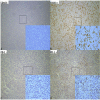Lymphocyte-to-monocyte ratio is associated with prognosis of diffuse large B-cell lymphoma: correlation with CD163 positive M2 type tumor-associated macrophages, not PD-1 positive tumor-infiltrating lymphocytes
- PMID: 28036275
- PMCID: PMC5354919
- DOI: 10.18632/oncotarget.14289
Lymphocyte-to-monocyte ratio is associated with prognosis of diffuse large B-cell lymphoma: correlation with CD163 positive M2 type tumor-associated macrophages, not PD-1 positive tumor-infiltrating lymphocytes
Abstract
The research aims to examine the prognostic value of the lymphocyte-to-monocyte ratio (LMR), neutrophil-to- lymphocyte ratio (NLR) and platelet-to-lymphocyte ratio (PLR) in diffuse large B-cell lymphoma (DLBCL). The relation of these hematologic indicators to poor antitumor immunity and prognosis must be investigated. Clinicopathologic data and survival information of 355 patients with DLBCL was retrospectively analyzed. Univariate analysis revealed that lower LMR (<2.71), higher NLR (≥2.81), CD163+ M2 tumor-associated macrophages (TAM) content ≥9.5% and programmed cell death 1 (PD-1)+ tumor-infiltrating lymphocytes (TILs) content < 4.5 cells per high power field(HPF) were significantly related to unfavorable overall survival (OS) and progression free survival (PFS). When considering the prognostic indexes of IPI, multivariate analysis confirmed that LMR of <2.71 and CD163+ M2 TAM content ≥9.5% significantly affected the prognosis of DLBCL. Spearman correlation test showed LMR was negatively correlated with CD163+ M2 TAM content. However, there were no correlation was found between LMR and PD-1+ TIL as well as between NLR and PD-1+ TIL content. These results indicated that decreased LMR lead to a weak anti-tumor immunity and could be used as a bad prognosis biomarker of DLBCL.
Keywords: diffuse large B-cell lymphoma (DLBCL); lymphocyte-to-monocyte ratio (LMR); neutrophil-to-lymphocyte ratio (NLR); programmed cell death-1 (PD-1); tumor-associated macrophages.
Conflict of interest statement
No potential conflicts of interest were disclosed.
Figures





References
-
- Project TIN-HsLPF. A predictive model for aggressive non-Hodgkin's lymphoma. The International Non-Hodgkin's Lymphoma Prognostic Factors Project. N Engl J Med.1993; 329:987–994. - PubMed
-
- Sehn LH, Berry B, Chhanabhai M, Fitzgerald C, Gill K, Hoskins P, Klasa R, Savage KJ, Shenkier T, Sutherland J, Gascoyne RD, Connors JM. The revised International Prognostic Index (R-IPI) is a better predictor of outcome than the standard IPI for patients with diffuse large B-cell lymphoma treated with R-CHOP. Blood. 2007;109:1857–1861. - PubMed
-
- Monti S, Savage KJ, Kutok JL, Feuerhake F, Kurtin P, M+ihm M, Wu B, Pasqualucci L, Neuberg D, Aguiar RCT, Cin PD, Ladd C, Pinkus GS, et al. Molecular profiling of diffuse large B-cell lymphoma identifies robust subtypes including one characterized by host inflammatory response. Blood. 2005;105:1851–1861. - PubMed
MeSH terms
Substances
LinkOut - more resources
Full Text Sources
Other Literature Sources
Research Materials

